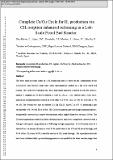Por favor, use este identificador para citar o enlazar a este item:
http://hdl.handle.net/10261/184875COMPARTIR / EXPORTAR:
 SHARE SHARE
 CORE
BASE CORE
BASE
|
|
| Visualizar otros formatos: MARC | Dublin Core | RDF | ORE | MODS | METS | DIDL | DATACITE | |

| Título: | Complete Ca/Cu cycle for H2 production via CH4 sorption enhanced reforming in a Lab-Scale fixed bed reactor |
Autor: | Díez-Martín, Laura CSIC ORCID; López Sebastián, José Manuel CSIC ORCID ; Fernández García, José Ramón CSIC ORCID ; Martínez Berges, Isabel; Grasa Adiego, Gemma CSIC ORCID ; Murillo Villuendas, Ramón CSIC ORCID | Palabras clave: | CH4 sorption enhanced reforming Fixed bed reactor Pressurized H2 production Ca/Cu cycle CO2 capture |
Fecha de publicación: | 15-jun-2018 | Editor: | Elsevier BV | Citación: | Chemical Engineering Journal 350: 1010-1021 (2018) | Resumen: | The three main reaction stages of a H2 production process based on the combination of the CaO/CaCO3 and Cu/CuO loops have been experimentally studied in a lab scale fixed bed reactor. The solid bed contained the three functional materials required to run the process, namely a commercial Ni-based catalyst, a CaO-Ca12Al14O33 CO2 sorbent and a CuO-Al2O3 material in a proportion that resulted in a bed with 43.3% wt. CuO, 25.6% wt. CaO and 1.7% wt. Ni. The system was able to convert 13.5 kg CH4 h−1 kg Ni−1, at 675 °C producing a gas stream with a 93.5% vol. H2 at 10 bar. The Cu-based material presented high oxidation kinetics, being totally converted in a narrow reaction front with a highly diluted air stream at 10 bar. The Cu-based material presented also fast reduction kinetics and it was completely converted with a fuel gas with typical composition of a Steam Methane Reforming stage at high temperature. A Cu/Ca molar ratio of 2 allowed for calcination efficiencies over 85% molar basis at the CO and H2 break-through, and 95% of the CO2 from CaCO3 exited the reactor at CH4 break-through. The experimental results have been validated with an existing pseudo homogeneous reactor model that had been developed in previous works for the three reaction stages. The model was able to predict product gas compositions, bed breakthrough, and temperature profiles along bed. | Descripción: | 7 Figures, 2 Tables.-- © 2018. This manuscript version is made available under the CC-BY-NC-ND 4.0 license http://creativecommons.org/licenses/by-nc-nd/4.0/ | URI: | http://hdl.handle.net/10261/184875 | DOI: | 10.1016/j.cej.2018.06.049 | Identificadores: | doi: 10.1016/j.cej.2018.06.049 issn: 1385-8947 |
| Aparece en las colecciones: | (INCAR) Artículos (ICB) Artículos |
Ficheros en este ítem:
| Fichero | Descripción | Tamaño | Formato | |
|---|---|---|---|---|
| CEJ_v350_1010-1021_2018.pdf | Artículo principal | 696,61 kB | Adobe PDF |  Visualizar/Abrir |
CORE Recommender
SCOPUSTM
Citations
25
checked on 11-abr-2024
WEB OF SCIENCETM
Citations
22
checked on 26-feb-2024
Page view(s)
344
checked on 18-abr-2024
Download(s)
237
checked on 18-abr-2024
Google ScholarTM
Check
Altmetric
Altmetric
Este item está licenciado bajo una Licencia Creative Commons

